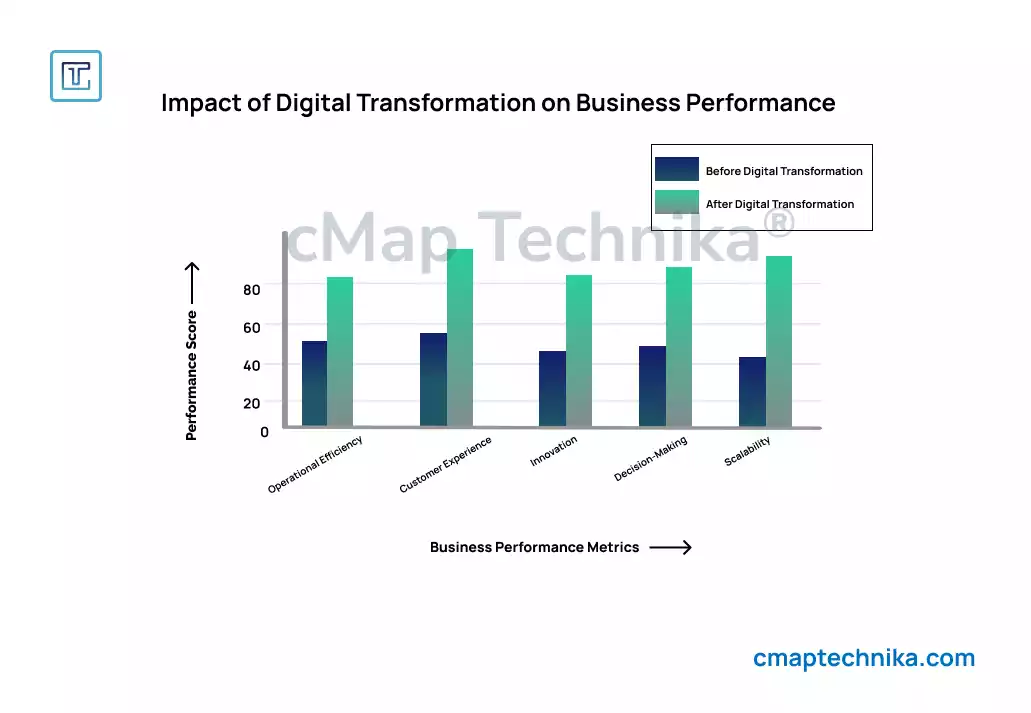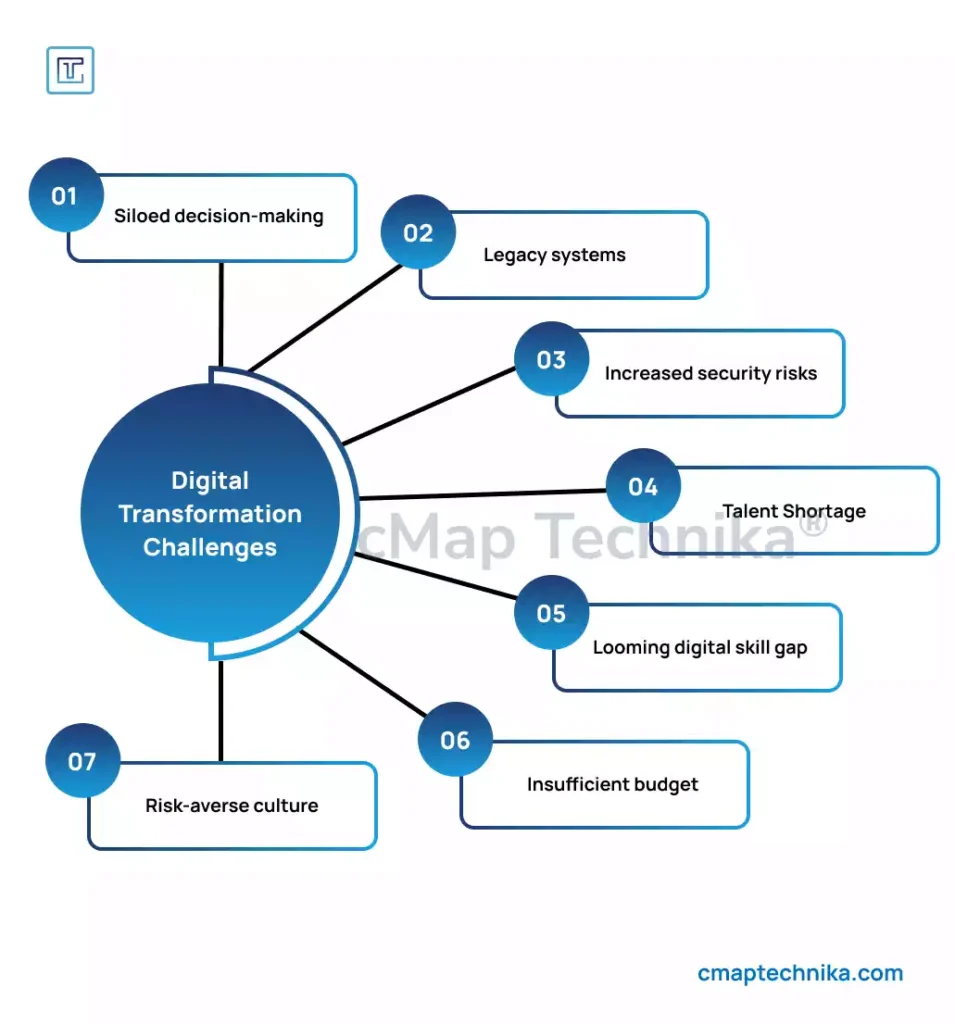Introduction
Digital transformation has become a defining imperative for modern enterprises seeking to remain competitive in an era of rapid technological advancement. Businesses across industries are facing mounting pressure to adopt digital strategies to enhance operational efficiency, improve customer experiences, and drive innovation. But digital transformation is more than just implementing new technologies—it’s about fundamentally rethinking how businesses operate, deliver value, and respond to market changes.
Enterprises that successfully embrace digital transformation leverage a combination of cloud computing, artificial intelligence (AI), automation, big data, and customer-centric platforms to enable real-time decision-making, enhance scalability, and streamline internal processes. However, the path to digital transformation is complex and multifaceted, requiring strategic alignment, cross-functional collaboration, and a culture of adaptability.
This article explores the key components of digital transformation, the driving forces behind it, the challenges businesses face, and the strategic benefits that come with effective implementation. Through real-world examples and insights, it highlights how leading enterprises are navigating the digital shift to drive long-term success.
What is Digital Transformation?
Digital transformation refers to the strategic adoption of digital technologies to improve business processes, products, services, and customer experiences. It involves the integration of advanced technologies such as cloud computing, AI, machine learning, big data, automation, and the Internet of Things (IoT) into core business operations. Unlike traditional digital upgrades, digital transformation is a holistic approach that reshapes the entire business model and operational framework.
Key Elements of Digital Transformation:

- Customer Understanding – Gaining deep insights into customer behavior and preferences through data analysis and feedback. Companies like Netflix analyze user viewing habits to recommend personalized content and improve user retention.
- Customer Touch Points – Ensuring a consistent and seamless experience across multiple interaction points (web, mobile, social, in-store). For example, Starbucks integrates its app with in-store experiences, allowing users to order ahead and earn rewards.
- Digitally Modified Business – Transforming business models using digital technologies. Tesla updates its cars’ software remotely, adding new features and improving performance without physical recalls.
- Top-Line Growth – Driving revenue through new digital offerings and personalized customer engagement. Spotify leverages AI to curate personalized playlists, increasing user engagement and subscription rates.
- Process Digitization and Automation – Automating repetitive tasks and streamlining workflows to increase efficiency. Siemens uses IoT and AI to automate manufacturing processes, reducing downtime and improving output quality.
- Data-Driven Decision-Making – Leveraging big data and predictive analytics to anticipate customer needs and market trends. Amazon uses predictive analytics to manage inventory levels, ensuring product availability and minimizing holding costs.
- Agility and Scalability – Implementing cloud-based infrastructure to enable rapid scaling, flexible resource allocation, and real-time response to market changes. Airbnb uses cloud infrastructure to scale its platform, handling spikes in traffic during peak seasons without downtime.
- Performance Management – Using real-time analytics and automated reporting to enhance decision-making. Salesforce enables businesses to track customer interactions and sales performance, allowing data-driven strategy adjustments.
Why Digital Transformation Matters

The business landscape has become increasingly volatile, with shifting customer expectations, supply chain disruptions, and competitive pressures driving the need for greater agility. Digital transformation equips businesses to address these challenges by creating a more responsive and adaptive operational model.
Increased Operational Efficiency
By automating routine tasks and streamlining business processes, digital transformation significantly reduces operational costs and improves resource utilization. For example, companies using AI-powered chatbots to handle customer service inquiries can cut response times and reduce staffing costs while maintaining high customer satisfaction levels.
Example:
Siemens, a global leader in industrial automation, leveraged AI and IoT to optimize its manufacturing processes. By integrating real-time sensor data with AI-powered predictive maintenance, Siemens reduced machine downtime by 20% and improved overall equipment efficiency. This digital transformation initiative helped Siemens scale its operations while minimizing production costs.
Enhanced Customer Experiences
Modern consumers expect seamless, personalized experiences across all touchpoints. Digital transformation enables businesses to capture customer data, analyze behavior patterns, and deliver tailored products and services in real time.
Example:
Netflix has mastered the art of personalization through data-driven recommendations. By analyzing viewing habits and user preferences, Netflix’s AI-driven recommendation engine accounts for over 80% of the content streamed on the platform. This level of personalization not only increases user engagement but also reduces churn rates, highlighting the business value of customer-centric digital strategies.
Faster Time-to-Market
Digital platforms and agile development frameworks allow businesses to develop, test, and deploy new products and services more quickly. Cloud-based infrastructure enables rapid prototyping and iterative product improvements without large upfront investments.
Example:
Adobe shifted from a traditional software licensing model to a cloud-based subscription service (Creative Cloud) to deliver continuous updates and feature improvements. This transition allowed Adobe to respond more quickly to customer feedback, accelerate product innovation, and increase recurring revenue.
Challenges in Implementing Digital Transformation

Despite its strategic advantages, digital transformation presents several operational, technical, and cultural challenges that businesses must navigate effectively to ensure success:
- Legacy Systems
Outdated infrastructure often lacks the flexibility and compatibility needed to integrate with modern digital platforms. Migrating from legacy systems to cloud-based or microservices-based architectures requires careful planning and substantial investment.
Example: General Electric (GE) faced difficulties modernizing its industrial equipment monitoring systems due to legacy infrastructure. GE gradually transitioned to a cloud-based platform using AWS, enabling real-time monitoring and predictive maintenance across its global network. - Siloed Decision-Making
Departments operating in isolation can create bottlenecks and misaligned priorities, limiting the effectiveness of digital transformation. Encouraging cross-functional collaboration and unified decision-making is critical to streamlining transformation efforts.
Example: Ford Motor Company addressed siloed decision-making by restructuring its IT and business teams into cross-functional units, enabling faster decision-making and alignment of digital initiatives with business goals. - Increased Security Risks
Digital transformation increases the attack surface for cyber threats. Enhanced data collection and cloud-based operations require strong security measures to protect sensitive customer and business data.
Solution: Companies like Salesforce and Microsoft have adopted end-to-end encryption, multi-factor authentication, and real-time threat detection to protect customer data and comply with regulations like GDPR and HIPAA. - Talent Shortage
A lack of skilled professionals in AI, cloud computing, and data science can hinder transformation efforts. Businesses need to invest in training and development to build in-house expertise.
Example: AT&T launched a large-scale reskilling initiative, training employees in AI, cloud technologies, and data science to support ongoing digital transformation projects. - Looming Digital Skill Gap
Even when talent is available, businesses often face a mismatch between current employee skills and the requirements of digital platforms. Upskilling and hiring specialized talent is essential for long-term success.
Solution: IBM created the SkillsBuild program to close the digital skills gap by providing free training and certification in emerging technologies, helping businesses equip their workforce for future demands. - Insufficient Budget
Digital transformation requires significant financial investment in infrastructure, software, and training. Budget constraints can delay or scale down initiatives.
Solution: Businesses can start with phased rollouts and leverage cloud-based models to reduce upfront costs while maximizing long-term value. - Risk-Averse Culture
A conservative organizational mindset can stifle innovation and slow down digital transformation. Creating a culture that embraces experimentation and adaptive learning is critical to overcoming this barrier.
Example: Adobe successfully transitioned to a subscription-based model by encouraging a risk-tolerant culture focused on customer feedback and iterative improvements.
Strategic Benefits of Digital Transformation
When executed effectively, digital transformation delivers significant long-term business value:
- Scalability and Flexibility: Cloud-based platforms and modular architecture enable businesses to scale resources up or down in response to changing market conditions.
- Data-Driven Insights: Real-time data analysis enables businesses to anticipate market trends and adjust strategies accordingly.
- Innovation and Competitive Advantage: Digital transformation fosters a culture of experimentation and innovation, allowing businesses to differentiate themselves in competitive markets.
- Improved Decision-Making: AI-driven analytics and automated reporting empower leaders to make faster, more accurate business decisions.
- Employee Productivity: Automation of routine tasks allows employees to focus on high-value strategic initiatives, improving overall productivity and job satisfaction.
Conclusion
Digital transformation is no longer an option—it’s a strategic necessity. Businesses that embrace digital technologies and reimagine their operational models will be better positioned to adapt to market changes, drive innovation, and maintain competitive advantage.
However, success requires more than adopting new technologies—it demands a shift in mindset, an investment in talent, and a commitment to continuous improvement. Companies that approach digital transformation with a strategic focus and a customer-first approach will unlock new levels of agility, efficiency, and growth in the digital economy.
The future belongs to enterprises that embrace digital transformation not just as a technological upgrade, but as a foundation for long-term strategic success.






